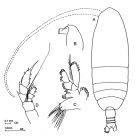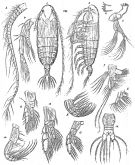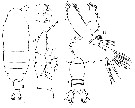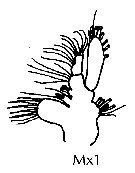|
|
 |
|
Calanoida ( Order ) |
|
|
|
Arietelloidea ( Superfamily ) |
|
|
|
Augaptilidae ( Family ) |
|
|
|
Haloptilus ( Genus ) |
|
|
| |
Haloptilus fons Farran, 1908 (F) | |
| | | | | | | Ref.: | | | Farran, 1908 b (p.69, Descr.F, figs.F); Sars, 1925 (p.245, figs.F); Rose, 1933 a (p.211, figs.F); Sewell, 1948 (p.504, 514); Matthews, 1972 (p.49); Tanaka & Omori, 1974 (p.264, figs.F); Björnberg & al., 1981 (p.653, fig.F); Park, 1988 (p.3, Descr.F, figs.F, Rem.); Bradford-Grieve & al., 1999 (p.882, 941, figs.F); Bradford-Grieve,1999 b (p.60, figs.F, figs.172, 190); Boxshall & Halsey, 2004 (p.69: fig.F); Vives & Shmeleva, 2007 (p.240, figs.F, Rem.) |  issued from : J.M. Bradford-Grieve in The Marine Fauna of New Zealand: Pelagic Calanoid Copepoda. National Institute of Water and Atmospheric Research (NIWA). NIWA Biodiversity Memoir, 111, 1999. [p.60, Fig.31]. Female: A, habitus (dorsal); B, forehead (lateral); C, Mx1; D, P5.
|
 issued from : O. Tanaka & M. Omori in Publs Seto Mar. Biol. Lab., 1974, XXI (3/4). [p.265, Fig.33]. Female: a, forehead (dorsal, rostrum underneath); b, idem (lateral); c, last thoracic segment and urosome (dorsal); d, idem (lateral left side); e, A2; f, Md (mandibular palp); g, Md (mandibular teeth); h, rostrum (frontal view); i, Mx1; j, Mx2; k, Mxp; l, P1; m, P2; n, P3; o, P5. Nota: The urosome segments and furca are in the proportional lengths as 42:9:11:14:24 = 100. Prosome and urosome are in the proportional lengths as 83:17 A1 extends beyond the end of the furca by 3 segments..
|
 issued from : T. Park in Antarct. Res. Ser. Washington, 1988, 47. [p.5, Fig.1]. Female: a, habitus (lateral right side); b, idem (dorsal); c, urosome (dorsal); d, idem (lateral right side); e, forehead (lateral); f, rostrum (anterior); g, A2. Nota: Rostral filaments well developed, originating from a conspicuous lobe when viewed laterally. Spermatheca relatively small, in the form of a short digital process when viewved laterally.
|
 issued from : T. Park in Antarct. Res. Ser. Washington, 1988, 47. [p.6, Fig.2]. Female: a, Md; b, Mx1; c, Mx2; d, Mxp; e, P1(anterior); f, P2 (anterior); g, P3 (anterior); h, P4 (anterior); i, P5 (anterior). Nota: Mx2 with 3 setae on all 6 protopodal lobes and 7 setae on endopod. Remarks: After Park (1988, p.2)H. fons is the most primitive species of the genus which has 5 teeth and a basal spine on the mandibular blade; a 3-segmented endopod on Mx1, 4 setae on the 2nd inner lobe; Mx2 with 3 setae on each of the six protopodal lobes.
|
 Issued from : G.O. Sars in Résult. Camp. Scient. Prince Albert I, 69, pls.1-127 (1924). [Pl.LXXI, figs.1-14]. Female: 1, habitus (dorsal); 2, idem (lateral left side); 3, A1; 4, A2; 5, left Md; 6, Md (right masticatory edge); 7, Mx1; 8, idem (endopodal segments, enlarged); 9, Mx2; 10, Mxp; 11, P1; 12, P2; 13, P5; 14, urosome (dorsal).
|
 issued from : G.P. Farran in Fish. Ire. Sci. Invest., 1906, II [1908]. [Pl. VII, Figs.11-15]. Female (from W Ireland): 11, habitus (dorsal); 12, P5; 13, Md (cutting edge); 14, Mx1; 15, urosome (dorsal).
|
 issued from : J.M. Bradford-Grieve, E.L. Markhaseva & C.E.F. Rocha & B. Abiahy in South Atlantic Zooplankton, Edit. D. Boltovskoy. 1999. Vol.2. Copepoda. [p.1042, Fig. 7.270]. Female: Mx1. Nota: Endopodite of Mx1 with 13 setae; exopodite with 11 setae; outer lobe1 with 9 setae.
| | | | | Compl. Ref.: | | | Hardy & Gunther, 1935 (1936) (p.182, Rem.: rare); VC.B. Wilson, 1950 (p.236); Deevey & Brooks, 1977 (p.156, tab.2, Station "S"); Kovalev & Shmeleva, 1982 (p.85); Brenning, 1985 a (p.28, Table 2); 1986 (p.14, Rem.); Madhupratap & Haridas, 1986 (p.105, tab.1); Razouls & al., 2000 (p.343, Appendix); Holmes, 2001 (p.13); Sameoto & al., 2002 (p.12); Schnack-Schiel & al., 2008 (p.1045: Tab.2); Park & Ferrari, 2009 (p.143, Table 4, Appendix 1, biogeography); Schnack-Schiel & al., 2010 (p.2064, Table 2: E Atlantic subtropical/tropical); Lidvanov & al., 2013 (p.290, Table 2, % composition); Belmonte, 2018 (p.273, Table I: Italian zones) | | | | NZ: | 14 | | |
|
Distribution map of Haloptilus fons by geographical zones
|
| | | | | | | | | | Loc: | | | Antarct. (W Weddell Sea, SW Atlant., Indian, SW & SE Pacif.), South Georgia, sub-Antarct. (Indian), Brazil - Argentina, NW Africa, Mauritania- Morocco (18°N), Atlantic (tropical), S Azores, off E Nova Scotia, off W Ireland, off Bermuda (Station "S"), Sargasso Sea, W Medit. (Tyrrhenian Sea), Philippines, Japan (Izu region), Pacif. (N temperate), SW Galapagos, off Peru, New Zealand (Cook Strait) | | | | N: | 22 | | | | Lg.: | | | (1) F: 4,8; (24) F: 6,6-5,7; (68) F: 5,14; (909) F: 6,15; (1108) F: 4,8; {F: 4,80-6,60} | | | | Rem.: | meso-bathypelagic. Known to occur below 1200 and above 600 m depth (Matthews, 1972). Sargasso Sea: 1500-2000 m (Deevey & Brooks, 1977, Station "S");
Sampling depth (Antarct., sub-Antarct.): 100-600 m.
Park (1988, p.4) points to the species distribued widely between 34°S and 74°S (ice shelf) n the Pacific Ocean sector and between 50° and 64°S in the Indian Ocean sector. | | | Last update : 05/02/2020 | |
|
|
 Any use of this site for a publication will be mentioned with the following reference : Any use of this site for a publication will be mentioned with the following reference :
Razouls C., Desreumaux N., Kouwenberg J. and de Bovée F., 2005-2025. - Biodiversity of Marine Planktonic Copepods (morphology, geographical distribution and biological data). Sorbonne University, CNRS. Available at http://copepodes.obs-banyuls.fr/en [Accessed December 27, 2025] © copyright 2005-2025 Sorbonne University, CNRS
|
|
 |
 |










